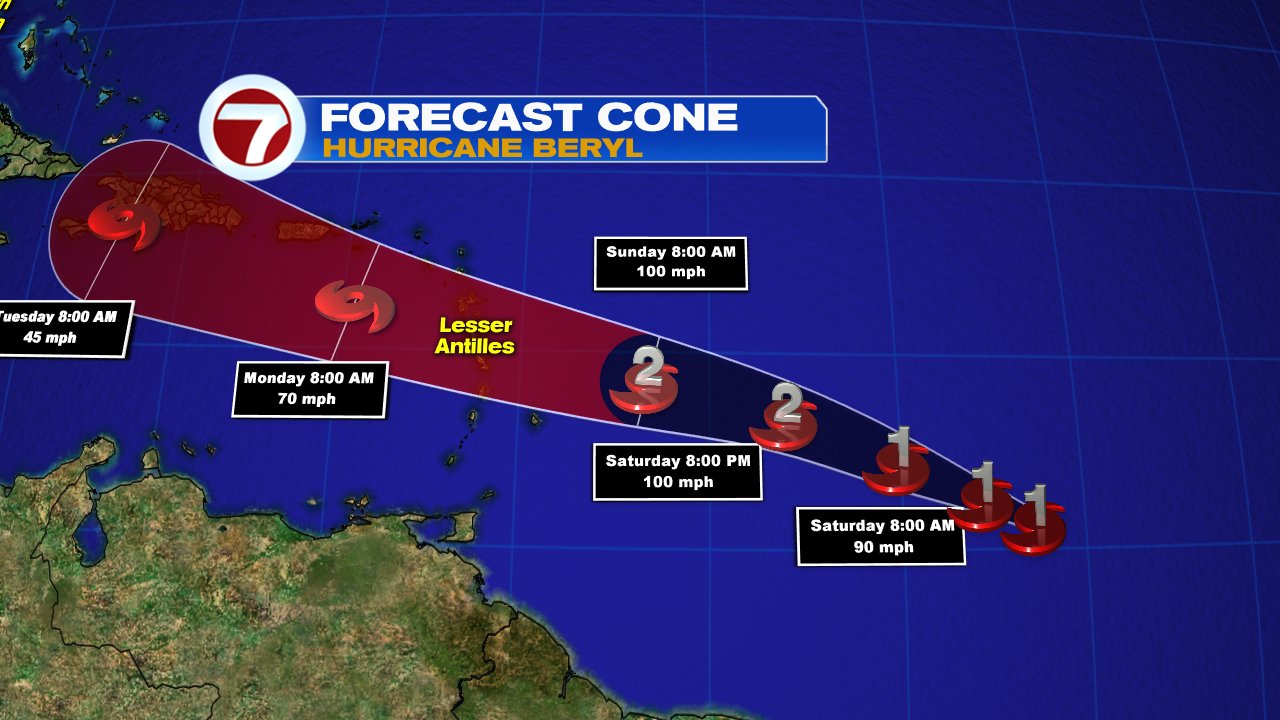This weekend will determine how strong/weak "Beryl" may be before in reaches the Lesser Antilles.
Throughout its duration it has been a little storm with big ambitions. It triumphed over dry air and Saharan dust to its north to reach hurricane status. Now it appears there is a bully in the road, and that is in the form of wind shear.
I mentioned yesterday that the entire cloud mass of "Beryl" could fit between Miami and Orlando with the dangerous hurricane winds covering only a 10 mile area. Its small eye made it vulnerable to disruptions. As of Saturday, the disruption appears to be happening as it no longer has hurricane force winds.
On the black & white satellite picture, you can see the comma shaped cloud mass almost in the middle of the screen, this is "Beryl". On closer inspection, the imagery suggests the eye is cloud free and now exposed to the elements.
There is some sheen on the picture to the west, north and east of "Beryl", this is Saharan dust. This dry air appears to finally be taking a toll with most of the rain sitting to the southeast of the center. This is not a good sign, as it needs plenty of moisture around the eye to keep it going.
The morning observations allowed the National Hurricane Center (NHC), to downgrade "Beryl" to Tropical Storm status. Conditions appear unfavorable that it can regain hurricane strength.
If the exposed center isn't enough to weaken it, there is a larger weather phenomena in it's path that should provide, if not a knock out punch, at least a standing 8 count.
Right over the Lesser Antilles there is strong shear waiting for "Beryl". These very strong upper level winds should cut down the system as it enters the Caribbean Sea. Some models call for "Beryl" to be just a tropical wave in about three days. Most models keep whatever is alive after the shear, either over Jamaica or the Bahamas. No need to be on alert in these areas, just keep an eye out in case it throws us a curve ball.
Where is it headed?
The steering winds will keep "Beryl" in a northwesterly path throughout it's life cycle. Even if it's just a storm as it approaches the Central Lesser Antilles, it is still capable of some rain and gusty winds.
- The government of Barbados issued a Tropical Storm warning for Dominica. The Hurricane watch has been cancelled.
- The government of the Netherlands issued a Tropical Storm Watch for Saba & St. Eustatius.
- Tropical Storm watches still in place for Barbados, St. Lucia, Martinique, Guadeloupe, & St. Martin
What can the islands expect?
Since "Beryl" is very small, the consequences of its arrival are not that clear, but NHC says:
- Tropical Storm force winds of 39+ mph, should speed over Dominica, and other islands under advisories, on Sunday night .
- The storm could drop as much 4 inches of rain across the Lesser Antilles. Very difficult to say exactly where because of its small size. Puerto Rico and the Virgin Islands could get between 1 - 2 inches. Some localized flooding is possible.
More tropical activity
Tropical Depression #3 is sitting offshore the Carolinas, and even though it's expected to get stronger over the next few days, it should remain away from land.
We'll keep you posted.






























